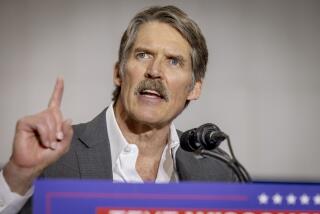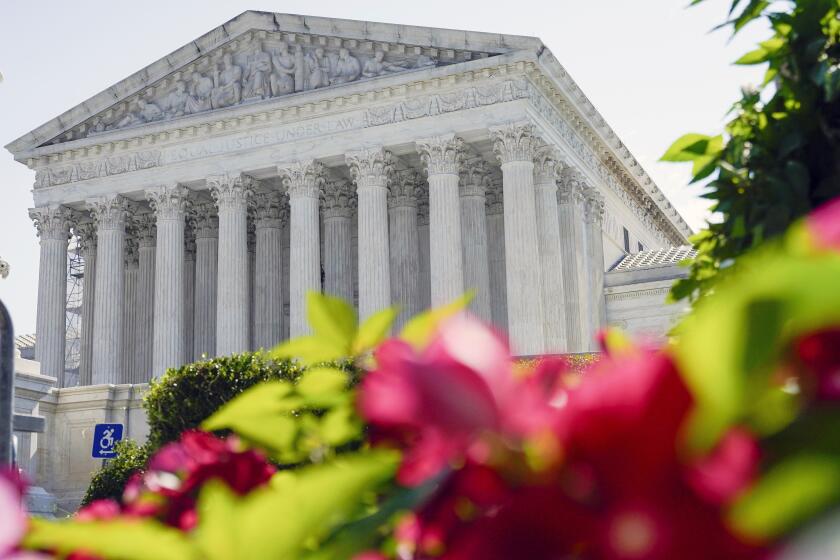New President Must Take Small Steps on Domestic Issues Before a Big Leap
It may not seem that way to readers already weary of Dubya and Mr. Liplock. But eventually the presidential campaign will end. (We promise.) And then either George W. (that’s Dubya to you, buddy) Bush or Al Gore (our wife-smooching vice president) will face the next challenge: accomplishing something in Washington.
Either will find the capital strangely unaccustomed to getting things done. Since the balanced budget deal in 1997, Republicans and Democrats alike have stopped exercising all the muscles they once used to make deals and reach compromises. Whoever wins, the two sides will find plenty to argue about after January as well. But if the new president is going to get anything done in the next Congress, he’ll need to take a step-by-step approach.
Before the two parties can reach agreements on the big questions--tax cuts, reforming Social Security, prescription drugs--they are likely to need what diplomats call “confidence building measures.” These are smaller steps that restore trust--and convince the two sides they can work together. Fortunately, on a number of domestic issues Bush and Gore have offered proposals similar enough that the two parties should be able to reach agreement, no matter who wins. And that could create the momentum for larger change.
Where could the next president go for some quick bipartisan agreements? Here’s a list of 10 ideas Gore or Bush (and in most cases both) are promoting that could command broad support in the next Congress. They fall into three categories.
HEALTH
* Insuring working adults: Innovative governors in both parties, from California Democrat Gray Davis to Wisconsin Republican Tommy G. Thompson, are pressing Washington for permission to cover uninsured parents whose children are eligible for the existing Children’s Health Insurance Program. Gore and Bush both like the idea, but only Gore has called for setting aside money ($55 billion over 10 years) to help states cover the cost. That is the better approach--states might be able to cover some adults with the funds Washington now provides for children, but any significant coverage increase will demand new money.
* Healthy kids: About two-thirds of the 12 million U.S. children without health insurance are eligible now for the Children’s Health Insurance Program or Medicaid. But many states have done a poor job enrolling them. Gore has sensibly proposed requiring states to pick up the pace or face a loss of federal funds. And he’s urged a series of practical enrollment reforms--including school-based sign-ups--that could quickly bring health care to millions of children.
* Community health: Even if Bush or Gore passes his full wish list of health care reforms, millions of Americans will still lack health insurance. That underscores the need to bolster the nation’s network of community health centers--federally funded, locally run institutions that provide safety-net care for the uninsured. President Clinton and Gore haven’t made this as much a priority, but Bush has proposed a $3.6-billion, five-year funding increase for the centers--an idea that builds on groundwork already laid by a bipartisan Senate coalition.
EDUCATION
* Accountability: If Bush hadn’t proposed it first, Democrats would undoubtedly be promoting his idea of requiring states to test students every year from third through eighth grade in reading and math--and then rewarding or penalizing states based on the results. Bush’s plan offers a basis for congressional compromise because centrist Democrats (led by Sen. Joseph I. Lieberman of Connecticut, Gore’s vice presidential choice) have already proposed a similar scheme that would give states more flexibility in spending federal money in return for tougher accountability. The flaw in Bush’s blueprint is the lack of a national yardstick to assess the state tests; that could be fixed by adding to the plan the voluntary national tests in reading and math that Clinton and Gore have urged.
* School construction: Both Gore and Bush have acknowledged that Washington should help local governments with the multibillion-dollar challenge of modernizing crumbling schools. But Bush, for ideological reasons, has proposed a Rube Goldberg scheme to meet the task. Clinton and Gore, backed by Rep. Nancy L. Johnson (R-Conn.) and a bipartisan coalition in the House, have a better idea: federal tax credits to pay the interest on local school construction bonds.
* Charter schools: Gore and Bush have both zeroed in on a central challenge facing charter schools, which operate free of most union and bureaucratic rules. States generally provide these new schools operating funds for their students but no start-up money to obtain and renovate their facilities. Both Gore and Bush sensibly propose to fill that gap with federal aid.
SOCIAL WELFARE
* Faith-based reforms: Both Bush and Gore want to give religion-based charities a greater role in delivering social services, such as treatment for drug abuse. Such a shift would both honor and accelerate the revival of community-based activism that is reinvigorating troubled neighborhoods around America.
* Fatherhood: Gore and Bush both want to provide grants to local groups that help reconnect absent fathers with their families and provide job training and placement for low-income men who are behind on their child support payments. Gore’s right when he calls this “the next phase in welfare reform.”
* Child care: Gore has adopted the best idea from Bill Bradley’s primary campaign against him: making the tax credit for child care more available to the working poor. Under current law, the people who most need help paying for child care--low-income working parents--often don’t get it because they don’t have any federal income tax liability; Gore would allow them to claim the credit as a refund on their taxes. That change could put up to $2,400 in the pocket of the waitress mom with two kids that Bush often cites--far more than his tax plan offers.
* Homeownership: Clinton and Gore have made great strides toward increasing homeownership among low-income and minority families by prodding banks to make more mortgage loans in working-poor neighborhoods. Bush has proposed a worthwhile follow-up: allowing low-income families to apply their federal rental vouchers toward the down payment on a new home.
*
See current and past Brownstein columns on The Times’ Web site at: https://www.latimes.com/brownstein.
More to Read
Get the L.A. Times Politics newsletter
Deeply reported insights into legislation, politics and policy from Sacramento, Washington and beyond. In your inbox three times per week.
You may occasionally receive promotional content from the Los Angeles Times.






